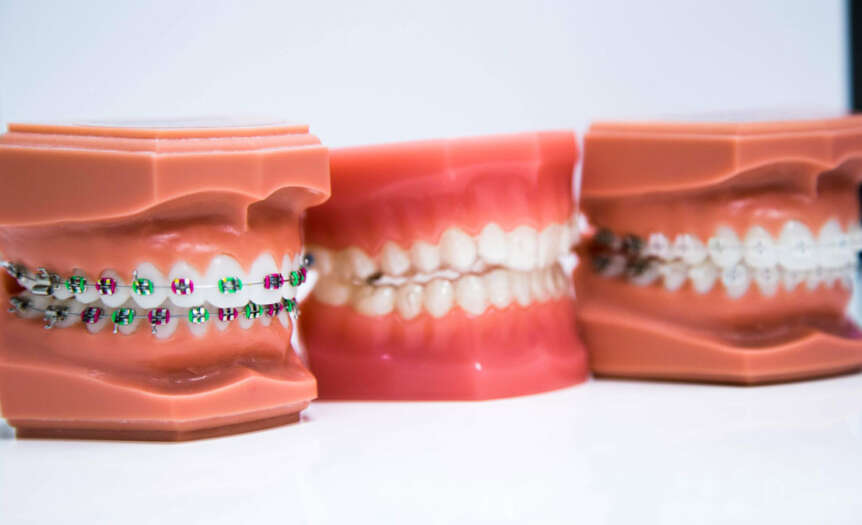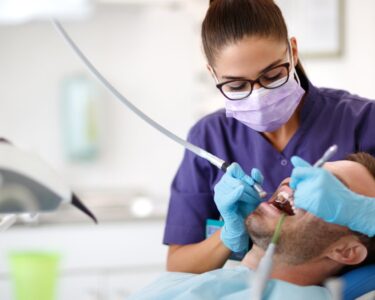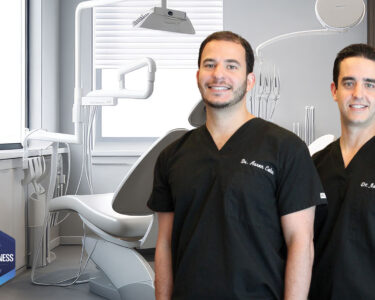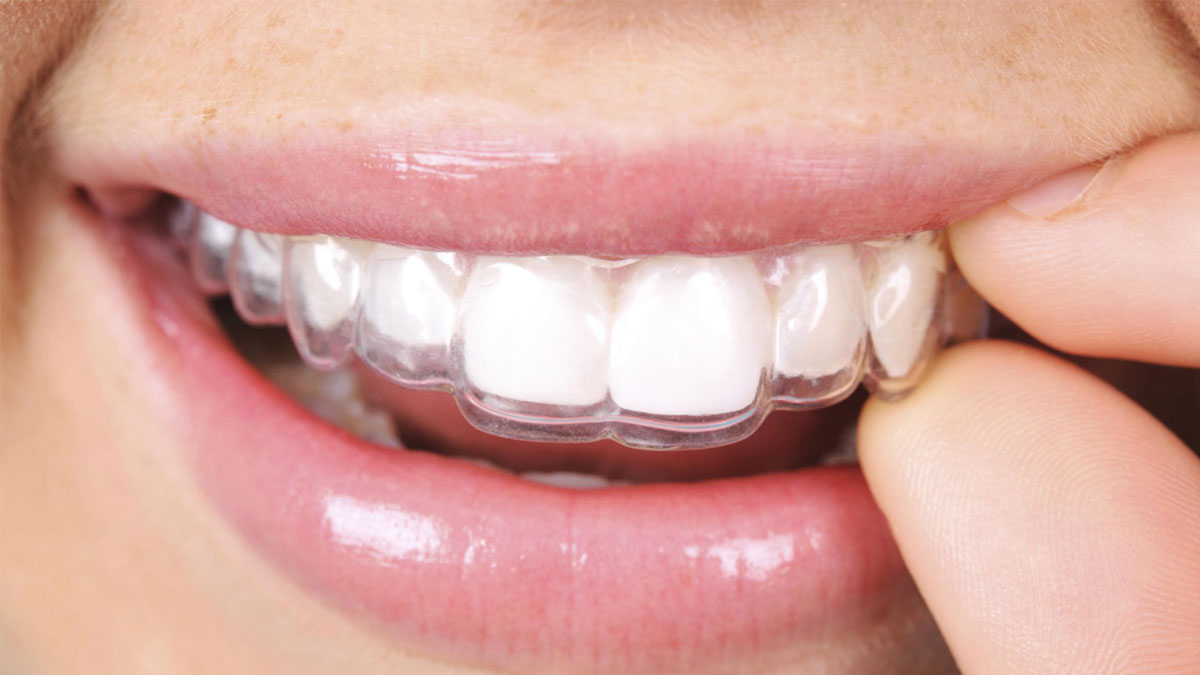When a new patient comes to my office and I determine that they need orthodontic treatment, the conversation inevitably leads to a comparison of braces versus Invisalign. Historically in orthodontics, braces were the go-to treatment modality for the correction of most orthodontic problems. However, the introduction of Invisalign clear plastic removable aligners 25 years ago has created a paradigm shift in the field.
Invisalign has forever changed the orthodontic landscape and is becoming an increasingly popular means to predictably straighten teeth and correct bites, not only for adults but also for teens and younger children. So now we have the choice, yet as with any decision in life, there are advantages and disadvantages to consider. Let us explore the different areas of concern when making the choice of braces versus Invisalign.
Hygiene: I list this parameter first, since there is nothing more important than healthy teeth. Invisalign is unquestionably the winner when it comes to hygiene. It is very challenging to brush and floss properly with braces, and since Invisalign is removable, brushing and flossing are essentially unaffected. The only additional requirement with Invisalign is that the aligners be cleaned (brushed) regularly.
Comfort: Invisalign is more comfortable than braces. Braces can be rather irritating to the inside of the mouth, particularly for adults who are more sensitive. While there are “attachments” or little tooth-colored shapes bonded to some of the teeth with Invisalign, these are distinctly smaller and less irritating than brackets and wires; and the smooth, clear plastic aligners fit on top of them. Additionally, the pressure from braces is significantly more than that felt with Invisalign aligners.
Emergencies: There are fewer emergencies with Invisalign than braces. In the case of braces, brackets can break and wires can shift, poke or break. In the case of Invisalign, attachments may come off or aligners edges may need to be smoothed; but these issues are uncommon and much less bothersome.
Compliance: This is the main factor that concerns patients with Invisalign. The fact that clear aligners are removable is both an advantage and a disadvantage. It is a huge plus with respect to all the parameters already mentioned; however, if aligners are not worn consistently (approximately 22 hours/day), they will not be effective, treatment time will be extended and/or results will not be optimal. Some patients say that they know themselves (or their child) and are confident that they will not be consistent with aligner wear and will break or lose the aligners and so opt for braces.
Convenience: This also can go either way. Some consider the in and out of aligners to be a hassle. However, maintenance appointments are almost half as many with Invisalign than they are with braces, so visits to the orthodontist are less frequent. Additionally, you can eat whatever you want with Invisalign, since they are removed to eat, while there are certain dietary restrictions with braces (e.g., no hard, sticky or chewy foods).
Aesthetics: Invisalign is nearly invisible, so it is the most aesthetic option — even more so than clear braces in which the wire is still moderately visible. Invisalign can also be removed for special occasions in which aesthetics are a particularly important factor.
Treatment time: Treatment time is the same for both braces and Invisalign (assuming compliance with aligners).
Results: They are also the same for most cases, again assuming compliance with aligners. Almost any case I would treat with braces I can now treat with Invisalign and achieve equally successful outcomes. This is true not only for minor cases but also for more complex, challenging cases and for both children and adults.
Cost: Pricing, of course, is dependent on several factors, including difficulty and length of the case. But generally, for a comprehensive orthodontic case in my practice, clear braces and Invisalign are very comparable in price.
Novelty: I do mention this because some people (particularly children) consider braces fun and cool (yes, cool!) and look forward to changing braces colors. Some parents also consider it a rite of passage, as it is something they went through as a child.
In summary, it is critical to consider all the factors when deciding between braces and Invisalign. Most important, it is necessary to consider your life priorities and follow your instincts and, as such, determine which orthodontic treatment will fit best with your or your child’s habits and lifestyle. At Pinecrest Orthodontics, we are here to guide you in the right direction!














 Deering Estate
Deering Estate
 Massage Envy South Miami
Massage Envy South Miami
 Calla Blow Dry
Calla Blow Dry
 My Derma Clinic
My Derma Clinic
 Sushi Maki
Sushi Maki
 Sports Grill
Sports Grill
 The Healthy Kitchen
The Healthy Kitchen
 Golden Rule Seafood
Golden Rule Seafood
 Malanga Cuban Café
Malanga Cuban Café

 Kathleen Ballard
Kathleen Ballard
 Panter, Panter & Sampedro
Panter, Panter & Sampedro
 Vintage Liquors
Vintage Liquors
 The Dog from Ipanema
The Dog from Ipanema
 Rubinstein Family Chiropractic
Rubinstein Family Chiropractic
 Your Pet’s Best
Your Pet’s Best
 Indigo Republic
Indigo Republic




 ATR Luxury Homes
ATR Luxury Homes


 2112 Design Studio
2112 Design Studio
 Hamilton Fox & Company
Hamilton Fox & Company
 Creative Design Services
Creative Design Services
 Best Pest Professionals
Best Pest Professionals
 HD Tree Services
HD Tree Services
 Trinity Air Conditioning Company
Trinity Air Conditioning Company
 Cisca Construction & Development
Cisca Construction & Development
 Mosquito Joe
Mosquito Joe
 Cutler Bay Solar Solutions
Cutler Bay Solar Solutions


 Miami Royal Ballet & Dance
Miami Royal Ballet & Dance
 Christopher Columbus
Christopher Columbus
 Pineview Preschools
Pineview Preschools
 Westminster
Westminster
 Carrollton
Carrollton
 Lil’ Jungle
Lil’ Jungle
 Frost Science Museum
Frost Science Museum
 Palmer Trinity School
Palmer Trinity School
 South Florida Music
South Florida Music
 Pinecrest Orthodontics
Pinecrest Orthodontics
 Dr. Bob Pediatric Dentist
Dr. Bob Pediatric Dentist
 d.pediatrics
d.pediatrics
 South Miami Women’s Health
South Miami Women’s Health

 The Spot Barbershop
The Spot Barbershop
 My Derma Clinic
My Derma Clinic




 Miami Dance Project
Miami Dance Project

 Rubinstein Family Chiropractic
Rubinstein Family Chiropractic
 Indigo Republic
Indigo Republic

 Safes Universe
Safes Universe
 Vintage Liquors
Vintage Liquors
 Evenings Delight
Evenings Delight





 Atchana’s Homegrown Thai
Atchana’s Homegrown Thai
 Baptist Health South Florida
Baptist Health South Florida

 Laser Eye Center of Miami
Laser Eye Center of Miami
 Visiting Angels
Visiting Angels
 OpusCare of South Florida
OpusCare of South Florida

 Your Pet’s Best
Your Pet’s Best





 HD Tree Services
HD Tree Services
 Hamilton Fox & Company
Hamilton Fox & Company


 Creative Design Services
Creative Design Services